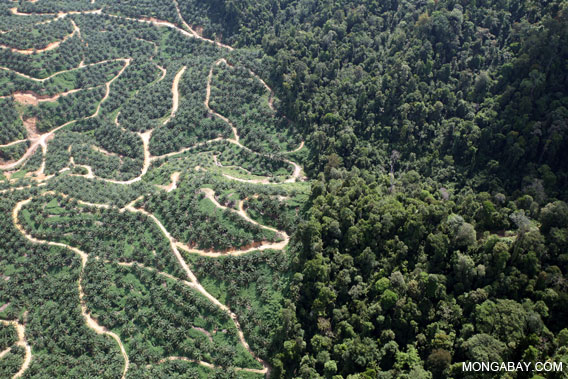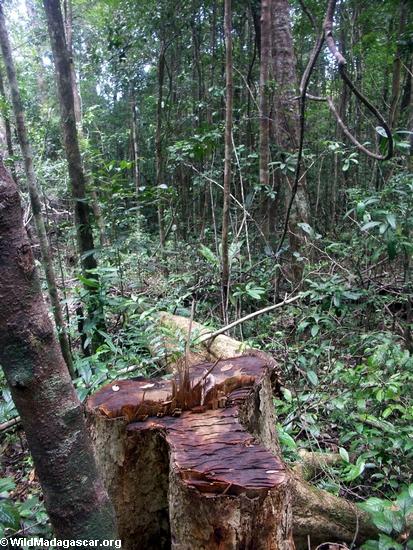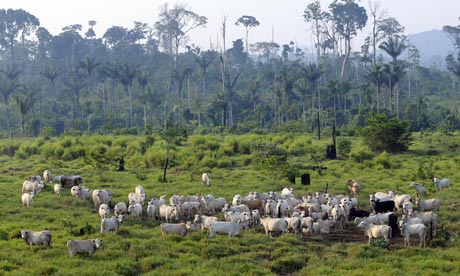In my last post I have explored some of the main
causes leading to deforestation and the clearing of large areas of land of
other activities. Most of the world’s deforestation activity occurs in
rainforests. So why should we not cut down the trees in the rainforests? This post
aims to explore the impact locally as well as globally.
Biodiversity
The global scale conversion of rainforests to agricultural
land is undoubtedly a major driver of local biodiversity loss in both fauna (Figure 1) and
flora where in turn has an impact on ecosystem functioning (Steffan-Dewenter I.et al., 2007). Having the largest
amount and the highest diversity of species (in 1ha in the Amazon there are
more species of plants than the whole of Europe! (GREENPEACE)) It is highly
likely that with the loss of their habitat these species will become extinct
due to their endemic distributions making them susceptible to any environmental
change. Adding to this, there are many species that are yet to be discovered and
documented and this is extremely important to medicine as a huge number cures
have become form rainforest plants (WebEcoist).
 |
| Figure 1: Some of the fauna in Costa Rica (The Costa Rican Times) |
One example of ecosystem
services that are going to be impacted in the long run due to deforestation, is
tree pollination. Priess J.A. et al., (2007)
suggest that there will be a decline in the pollination services in relation to
forest conversion directly reducing 18% of coffee yields that in turn will
reduce the net revenues up to 14% in the next 20 years (Figure 2).
 |
| Figure 2: The Asian giant honeybee, Apis dorsata, is one of a number of pollinators of coffee in southern India (ETH) |
Climate
The Amazon basin has the drainage basin area of about 7 million km2 making it the biggest watershed in the world. It contributes 13% of the total runoff of the globe in to the oceans. In addition to this, 50-60% of the precipitation of the area is attributed to the evapotranspiration (Figure 3) of the flora of that basin and thus having a large impact on the energy as well as the water balance regionally and globally. In the scenario of severe deforestation, and thus a degree of land restructuring will alter the atmosphere dynamics with water flux weakening (D’Almeida C. et al.,2007).
In the
case of the Northern Hemisphere circulation, it has been observed that there is
statistical significance between deforestation effects on the NE Atlantic
winter rainfall that could extent towards Europe (Gedney N. & Valdes P. J.,2000)
The deforestation
in Southeast Asia resulted to the decrease in precipitation that was observed outside
the deforested area through winds. Werth D. & Avissar R. (2005) observed a
proportional relationship between the impact of the magnitude and the degree of
deforestation.
The
storage of carbon also changes by deforestation which in turn has an impact in
the global climate. Carbon release through forest degradation in addition to
deforestation, is the 2nd largest emission of greenhouse gas
(Soares-Filho B. et al., 2010). 50%
of CO2 emissions are a result of forest fires and the rest are from
respiration of organic material in the undergrowth (Van Der Werf G.R. et al., 2009).
Flooding & Mudslides
One of the characteristic of the tropics is daily rainfall and hence RAINforests exist there. The biome has developed and adapted to the heavy rainfall through specialisations resulting to ¾ of the water from precipitation to be interrupted by vegetation. With deforestation, there is little vegetation to control water flow resulting to severe flooding. Flooding also causes mudslides (Figure 4) where the soil becomes loose with the absence of roots leading to these two devastating effects. Furthermore, aquifers become depleted since there are decreasing infiltration rates and the water reaches the oceans as runoff. The decrease of the essential fresh water in the aquifers is a main problem for the ever growing population the tropics (Hilderman R., 2010).
Flooding & Mudslides
One of the characteristic of the tropics is daily rainfall and hence RAINforests exist there. The biome has developed and adapted to the heavy rainfall through specialisations resulting to ¾ of the water from precipitation to be interrupted by vegetation. With deforestation, there is little vegetation to control water flow resulting to severe flooding. Flooding also causes mudslides (Figure 4) where the soil becomes loose with the absence of roots leading to these two devastating effects. Furthermore, aquifers become depleted since there are decreasing infiltration rates and the water reaches the oceans as runoff. The decrease of the essential fresh water in the aquifers is a main problem for the ever growing population the tropics (Hilderman R., 2010).
 |
| Figure 4: Heavy landslides claiming lives in Malaysia (THE WATCHERS) |
In general deforestation destructs the healthy
functioning of the biome and has severe effects globally as well as locally on
the environment and the ecosystem services it provides. The most likely to be
impacted by deforestation in short term are the surrounding population where in
most cases are from developing countries and thus increasing the impact due to
poor infrastructure.









